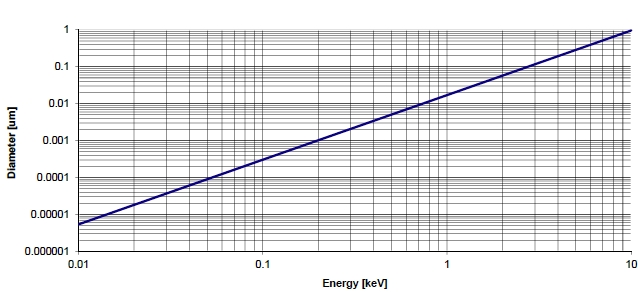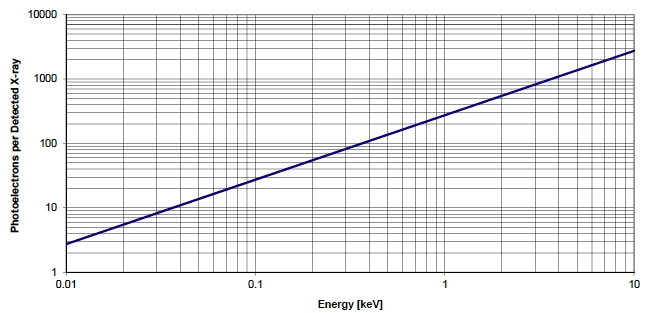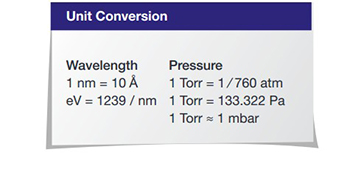Resources
 Part of the Oxford Instruments Group
Part of the Oxford Instruments Group
Expand
Collapse
 Part of the Oxford Instruments Group
Part of the Oxford Instruments Group

Figure 1: X-ray event diameter as a function of energy
Direct detection occurs when an incident photon is absorbed within the silicon of the CCD, resulting in the production of the electronhole (e-h) pairs. If this absorption occurs within the depletion region of the CCD, the electrons and holes are separated by the applied internal electric field, generated by the CCD’s electrode structure. The electrons are being trapped by the field and the holes undergo rapid recombination. The trapped electrons can subsequently be ‘clocked’ to the amplifier and readout. For this reason only the electrons of the e-h pairs formed in the depletion zone will be read out as signal. When an incident photon is absorbed, the number of e-h pairs formed and the size of the cloud they form in the silicon is directly related to the energy of the incident photon. These relationships are shown in the graphs and tables that follow.
The equation holds for photon energies >10 eV, assuming an ideal quantum yield.
Ne-h - Average number of e-h pairs formed
Ee-h - Energy required to generate an e-h pair 3.65 eV/e-for Silicon at RT
E(eV) - Energy of the incident photon
Energy-Dispersion Detection

Figure 2: X-ray event diameter as a function of energy
The relationship between incident photon energy and the number of electrons that are generated in the CCD means that in a low flux situation, single photons per pixel events, the energy of the X-ray source can be calculated. This powerful technique is key for EDS [energy-dispersive spectroscopic] applications. This is possible by using the histogram generated from the image pixels signal levels. The peaks found in this histogram give a count level from which the number of electrons generated can be derived using the cameras sensitivity, the incident photon energy can then be found.
Energy Resolution
The energy resolution is a measure of the ability to resolve individual energy lines. It can be calculated by the FWHM of the energy peaks. The theoretical limiting energy resolution for a CCD is related by the equation* below

FWHM(eV)=2.355[E(eV)Ee-hFa]½
Fa= Fano Factor= 0.1*
E(eV)= Energy of incident photon
Ee-h=energy to generate a e-/h pair
The direct detection energy resolution of a CCD camera is an effective method of testing the performance of the camera. The design and interface must be optimal to approach the theoretical energy resolution, with all the cameras key performance parameters optimised.
Andor builds the worlds leading cameras because we optimise these parameters to achieve the best system performance, from the design through to the final build stage of our world leading camera platforms. Across the system’s key parameters the highest performance must be achieved; charged transfer efficiency [CTE], the noise of the electronics, the lowest dark current a linear response over the entire dynamic range, at Andor we do this as standard.
| Energy Range (eV) | e-h pairs generated per absorbed photon |
| 1.1-3.1 | single e-h pair |
| >3.1 | multiple e-h pairs |
Table 1. Relationship of electron whole generation to energy range
| X-ray photon energy (keV) | Wavelength (nm) | Wavelength (Â) | e-h pairs generated per detected X-ray | Diameter of electron cloud (μm) | Calibration Source |
| 0.01 | 124.00 | 1240 | 3 | 0.00001 | |
| 0.1 | 12.40 | 124 | 27 | 0.00030 | |
| 0.5 | 2.48 | 24.8 | 137 | 0.00508 | |
| 1 | 1.24 | 12.4 | 274 | 0.01710 | |
| 5 | 0.25 | 2.48 | 1370 | 0.28589 | |
| 5.9 | 0.21 | 2.1 | 1616 | 0.38193 | Fe55Kα |
| 10 | 0.12 | 1.24 | 2740 | 0.96160 | |
| 11 | 0.11 | 1.13 | 3014 | 1.13614 |
Table 2. Table of key parameters
*The Fano Factor is an empirical constant used to determine the variation in charge generated when an X-ray photon or particles interact. The factor is empirically derived and is determined to be 0.1.
Reference James R. Janesick –Scientific Charge–Coupled Devices
